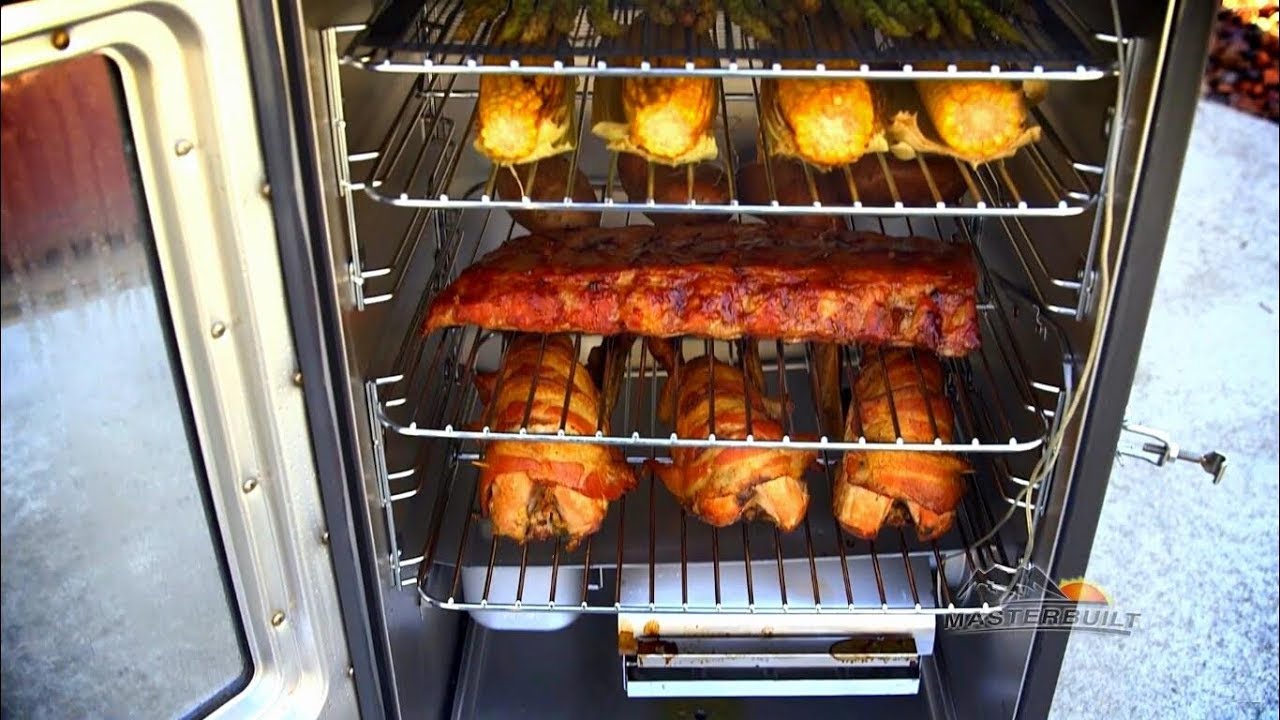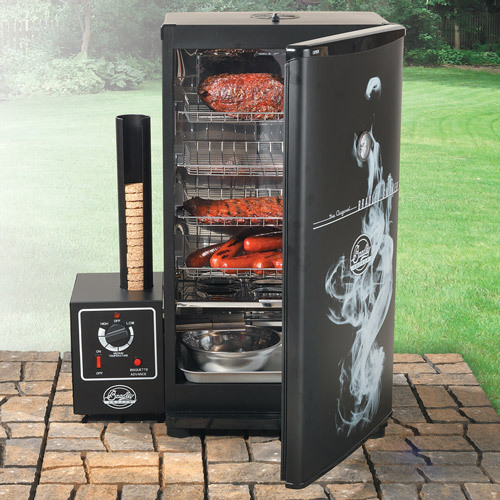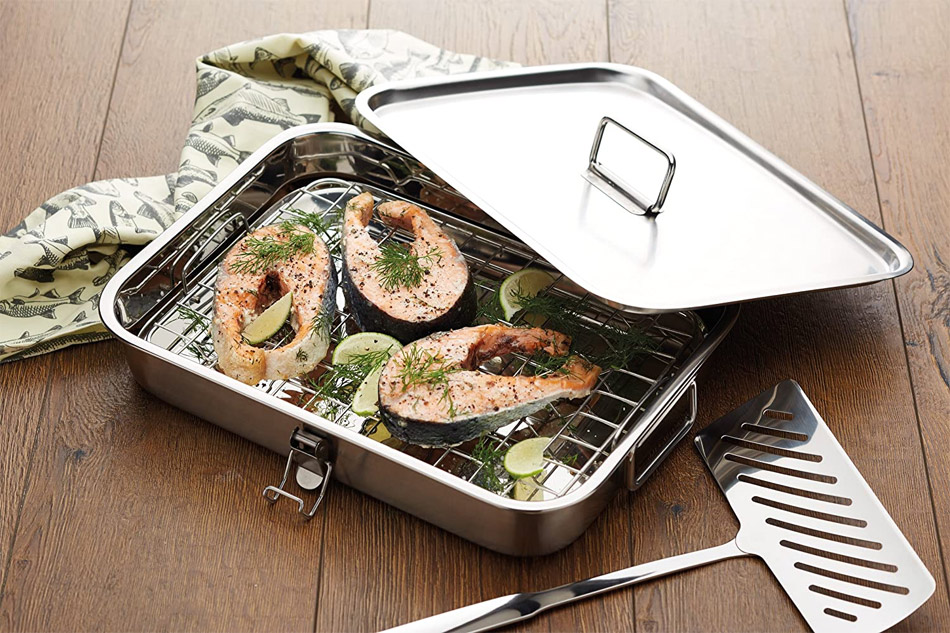
Meat smoker

Meat smoker
The process of smoking, whether meat, fish or vegetables is more complicated than making a simple barbecue, it can be done in a simple hole in the ground but we all like to do it more in a device prepared for it. The appliance is more expensive than a normal barbecue, the process takes longer and is more complicated, but the result is spectacular, that meat with a smoky flavor that melts is second to none.
Smoking is a type of grilling or slow cooking a food over low heat. Equipment and personal preferences determine which foods to choose for grilling or smoking. Smoking adds a pleasantly deep, woody flavor to foods, so a smoky flavor is sometimes added to sauces and vegetables; but true charcoal grilling and smoking is really only made with great cuts of meat, such as pork shoulders, whole chickens, flanks, and beef ribs. Understanding the advantages and disadvantages of grilling versus smoking will help you decide which is the best option for serving your guests.
Decisive moments
Charcoal grilling does not refer to food grilled over hot coals and slathered with a sauce, but rather a method of slow cooking the meat. Usually refers to a process whereby meat is prepared over a wood or charcoal fire over a low heat of 200 to 250 degrees. Tough meats are generally chosen for charcoal grilling, as prolonged cooking over low heat helps break down the collagen fibers in the meat, resulting in a silky and very soft meat dish.
Smoking is a charcoal-grilling process that occurs when food is cooked with indirect heat at a temperature usually below 200 degrees. Smoking also means adding a smoky flavor to food, such as liquid smoke.
Necessary equipment
For a true charcoal grilling experience, you need something that resembles a well, be it a grill, a covered charcoal burner, or a fire pit. The heat is indirect, so it is not necessary to turn the meat, but during grilling the lid must be lifted to change the pieces of charcoal. The disadvantage of this process is that it subsequently exposes the meat to the air and therefore dries out.
A smoker also needs a closed container, but you don't have to move the meat while you're cooking to accommodate the charcoal chunks. Thanks to this the final product can be more humid and more succulent, especially when it comes to cuts of lean meat and poultry. The problem is that you will need an external heat source attached to your cooking pan to generate the smoke. To keep the heat source at a constant temperature, which is necessary if you want to smoke your food rather than burn it, you may need to be fixing your heat source regularly, adding more wood and stirring the embers. If you are really interested in smoking, you'd better buy a smoker, which is specially made for this activity and keeps the temperature relatively constant. This means less work for you while your meat is cooking, but requires an additional investment of money.
Flavor
Smoked foods take on a distinctive flavor, usually from the wood used during the cooking process. If you like the taste of walnut, cherry or apple woods in your meat, smoked is for you. Be aware that smoking can create an unpleasant dish if you use mesquite, which can be too spicy for many guests, and woods from sap trees, such as pine, which can ruin food due to sparks and slightly toxicity. Smoked meats also tend to be moister than grilled or charcoal-grilled foods, and they soften more easily.
You can impart a smoky flavor when grilling if you use wood in a charcoal or wood-burning grill, although wood cannot be used in all grills. Food tastes less intense if you choose charcoal or gas.
Adding liquid smoke to food, from potato salad to meat marinade, is easy to mimic the taste of long, slow cooking, but it can overload the dish and make food taste artificial and processed. Liquid smoke works well for seasoning sauces and vegetables, like summer squash and bell peppers, that are not appropriate for hours in a closed smoker. But it cannot be compared to using a smoker, the liquid smoke will give us the flavor but the texture of the meat will not.
Use two thermometers to ensure safe smoking
To ensure that meat and poultry are smoked properly, you will need two types of thermometers: one for food and one for the smoker. A thermometer is necessary to monitor the temperature of the air inside the smoker or grill and ensure that the heat is maintained at temperatures between 225 and 300ºF (107.2 and 148.8ºC) during the cooking process. Many smokers contain built-in thermometers.
Use a food thermometer to check the temperature of meat and poultry. You can use an oven thermometer and keep it inserted into the meat during cooking. Use an instant-read thermometer after removing the meat from the smoker. .
Cooking time depends on many characteristics: the type of meat, the size and shape of the meat, the distance from the food to the heat source, the temperature of the charcoal, and the climate. It can take 2 to 8 hours to smoke meat or poultry, so use thermometers to monitor temperatures.
Smoke food to a safe minimum internal temperature.
Beef, veal, and lamb, fillets, roasts, and chops can be cooked at 145ºF (62.77ºC).
All cuts of pork, until reaching 160ºF (71.11ºC).
Ground beef, calf and lamb, until reaching 160ºF (71.11ºC).
All birds should reach a safe minimum internal temperature of 165ºF (73.88ºC).
If you are using a sauce, add it during the last 15 to 30 minutes of the smoking process to prevent over-browning or burning.

Meat smoker

Meat smoker
Season the meat with a dry marinade or marinate it to add flavor. Now that the smoker is ready, it is time to prepare the meats that you are going to cook. You can coat heavier cuts such as ribs, breasts, and pork shoulders with an even layer of dry spices for maximum flavor. You can marinate more delicate meats like chicken, fish, and cutlets overnight with your favorite acid-based marinade. You can quickly search the internet for dozens of delicious homemade recipes for dry marinating and marinating meats. Although seasoning is not an essential step, it is a simple way to enhance the natural flavor of meats.
Place the meat directly on the racks inside the smoker chamber. You can use meat tongs or a spatula to transfer the pieces to the grills and smoke them safely. You should order the meat according to the configuration of the grills. Place the larger pieces on the wide lower racks and place the smaller ones on the upper racks. You may need to insert heavy cuts of meat (like pork loin or ribs) by hand. Make sure to put on a thick pair of gloves before proceeding to protect yourself from burns. To prevent smoke from escaping, try to leave the door open for as little time as possible.
Close and lock the smoker door. Twist the door to close, then flip the latch next to the handle to secure it. By locking the door, you will prevent it from opening accidentally and letting heat or smoke escape - you should always use the built-in handle to open and close the smoker door. The metal on the surrounding parts of the door can get too hot and burn you if you're not careful.
Smoke meats for as long as the recipe calls for. This procedure could take anywhere from 2 to 8 hours, depending on the type of meat you are working with. You should consult the recipe to have a more precise idea of how long you will need to smoke the meats. In the meantime, avoid opening the smoker unless it is to fill the water container. Unlike other cooking methods, smoking requires a lot of patience. You can have the smoker itself bring a thermometer to puncture the meat, if not in the market you have many models.
Add more wood chips or water as needed while the meat smokes. A good way to tell if you need more wood or water is to watch the smoke. As soon as it stops coming out, you should open the chamber and refill the water container to the brim. Next, load 1 to 4 cups (150 to 600 g) of wood chips onto the pan, slide it back into place, and continue to smoke the meats. Note that if the chip tray is empty, it does not necessarily mean that you need to refill it. In fact, many barbecue enthusiasts insist that most meats can be successfully smoked with a single tray. Be careful, if you over-smoke the meat, it can end up with an unpleasant burnt taste.
Let the meat sit for 15 to 20 minutes before eating it. Once the meats are fully cooked, turn off the smoker, unlock the door, and carefully remove them from the racks. Set them aside on a separate surface to cool. Once the meat has reached a safe temperature, you can serve it and watch it disappear before your eyes of how good it will be. If the meat is not done yet, you may need to return it to the smoker for an additional 1 to 2 hours, depending on the recommended internal temperature. Transfer the remaining pieces to an airtight container and store in the refrigerator. They will likely keep for at least 4 days, although they can last much longer if you haven't cut them yet.

Meat smoker
1 - Unplug the smoker and let it cool completely. Before you begin cleaning your electric smoker, make sure it is cool enough to handle its components and interior surfaces safely. Press the power button again to turn off the smoker, then unplug the power cord from the outlet to cut off the electricity. If you don't unplug your smoker, you could put yourself at risk of burning yourself or receiving an electric shock, even if the device is turned off.
To ensure that all cooked meats have a perfect smoky flavor, it is recommended that you clean the smoker every time you use it.
2 - Remove all removable accessories from the smoker. These include the racks, water container, and chip tray. The racks and pan should simply slide out, while the water container is often located in the bottom of the smoker chamber. Set these items aside so you can easily re-insert them as soon as you're done, or clean them separately if necessary. Don't forget to empty and rinse the container if it has water that you've used previously.
3 - Use wet absorbent paper to remove any large residue. Scrape large food particles and stubborn grease from the front of the open smoker. Grab a broom and dustpan to sweep up the debris as soon as you're done. [23]
If there is too much residue left in the smoker, it may be a good idea to spread a layer of absorbent paper in front of the smoker to catch everything you extract from inside. Then you can simply fold it up and throw it away.
4 - Scrub the inside of the smoker chamber well with a mixture of water and detergent. For maximum cleaning power, you can use a kitchen sponge or a stiff-bristled brush to apply the detergent solution more deeply and remove greasy residue. Make sure to clean the inside of the door, as well as the 3 walls, floor, and ceiling of the smoker.
If your smoker racks look especially dirty, you can scrub them while they're outside. You can put the water container and chip tray in the dishwasher, or rinse them under a tap to remove a light layer of ash or soot.
Avoid using steel wool or other abrasive cleaning tools, as they can leave scratches on the inside surfaces of the smoker.
If it's been a while since you last cleaned your smoker and you notice mold growing inside it, you should leave it empty for 3-4 hours to burn before hand scrubbing as usual.
5 - Use a clean, damp cloth to clean the smoker. Once you've scrubbed the device, you should give it another pass to remove the detergent solution. You can also spray some clean water on it with a spray bottle if you don't want to create more of a mess. You can also use a degreaser.
If you have a smoker with an exposed heating element inside, avoid spraying it directly.
6 - Dry in the smoker with a clean cloth or a folded piece of absorbent paper. Wipe the cloth or absorbent paper over the entire surface of the smoker chamber to remove as much standing water as possible. Then, let the smoker sit with the door open to allow the remaining moisture to evaporate. Once the interior is dry, the smoker is ready for another round of perfectly simmered meats.
If you have a little time or don't want to bother drying your smoker by hand, simply open the door and let time do the rest.
Keeping the outside of the smoker clean is as simple as wiping it with a damp cloth from time to time or putting a protective bag on it, some smokers already usually include one

Smoker for home
They say that fire made us human or, rather, that the control of fire and its application in food made us human, because cooking them achieves greater efficiency in digestion and absorption of nutrients. But nowadays eating is not only meeting needs, it is also a pleasure, and it seems that in that pleasure marked the origin of cooking over fire, with the aroma and flavor that it transfers.
We like wood-fired cooking, barbecue, smoked food products (salmon, jerky, ham, tofu ...) and we can even use smoked salt, smoked olive oil or liquid smoke to provide that touch of smoke to our preparations culinary, although, honestly, they have nothing to do with it. There are kitchen utensils that achieve this in a more natural way, both for professional kitchens and for domestic kitchens, surely you know the smoke pipe, but there are many others.
Oven and barbecue
There are also other types of smokers, such as pots or similar containers. It consists of a kind of tray in which the wood shavings are placed, on which a grid is arranged on which the food to be smoked will settle. It is then covered and hermetically closed to prevent the smoke from escaping.
There are ovens to make homemade smoked fish, they are usually made of stainless steel, so it is a kitchen utensil that can be used for life and not only in the oven, it can also be used on the barbecue. Fish, meats, vegetables, fruits ... whatever we want, we can smoke it very easily, it will be enough to place the soaked chips in the base of the oven smoker, then the rack, the food to smoke and cover.
The smoker is introduced into the oven and as the wood heats up, it will release smoke and transfer its aroma to the food. Do not forget that there are shavings of different woods and that each one transfers an aroma and flavor, in addition, these shavings can be moistened with wine, whiskey or another liquid that gives it characteristic notes, and aromatic herbs and spices can also be added to taste.
What is smoked
Food smoking is a food treatment technique that originated, like many others, for its preservation. It consists of exposing the food to a stream of smoke that is usually generated by the partial combustion of wood chips.
Smoking was done in the past not only because it imparts flavor and aroma, but mainly because by partially drying the surface of the food it helps to preserve it better. Additionally, many substances in smoke are preservatives.
Now, thanks to the refrigerators, we do not need to smoke strictly to preserve, but because the flavor that smoking gives is peculiar and wonderful. Because we like it, in short.
Types of smoking
There are two smoking techniques depending on the temperature used:
Cold smoking: the food is subjected for 24 to 48 hours to a stream of smoke at a temperature that does not exceed 30 ºC(86 ºF). It is the technique with which the commercial smoked salmon that we all know is prepared. The food in this warm smoke stream undergoes changes, but is not cooked according to the traditional meaning of the term (denaturation and coagulation of proteins); its consistency still resembles that of raw food to some extent. The long period of exposure to smoke allows it to penetrate the entire food, flavoring it completely.
Hot smoking: as in cold smoking, the food is kept in a stream of smoke, but at a temperature higher than 60 ºC (140ºF), so the food is cooked, but also acquires a delicious smoked aroma. By smoking at a higher temperature, the process is much shorter than cold smoking and the flavoring of the piece is more superficial.